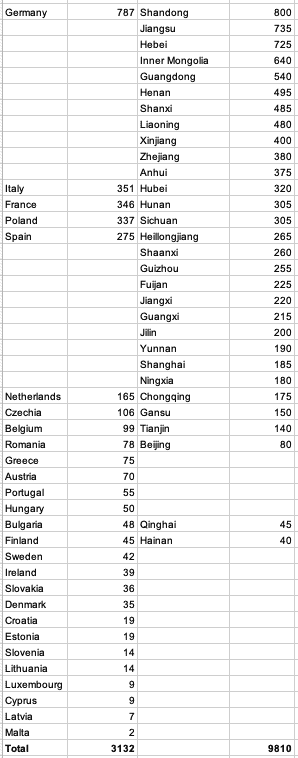This was supposed to be a big year for climate politics. It has lived up to expectations. But not, perhaps, in quite the way Europe had imagined.
In January, sights were set on the next round of the United Nations climate conference, ‘COP26’, scheduled for Glasgow in November, just days after the elections in the United States. The strategy of the European Union was to broker a deal with China to raise its national commitment under the terms of the Paris Agreement of 2015. To get there, diplomatic attention focused on the EU-China summit billed for Leipzig in mid-September.
Then the coronavirus hit. COP26 was postponed. Given the origin of the viral outbreak in Wuhan, relations between China and the west deteriorated sharply. Leipzig was downgraded to a conference call.
The online exchanges were, by all accounts, meatier than expected. But that was no preparation for what happened next. On September 22nd, the general secretary of the Chinese Communist Party, Xi Jinping, made a surprise announcement: China would aim for carbon neutrality ahead of 2060.
Xi has done big climate policy before. In November 2014 he appeared alongside the then US president, Barack Obama, to declare that China—despite its status as a developing country and although the climate problem was the historical responsibility of the west—would make commitments to curb its emissions from 2030. That declaration opened the door to the Paris Agreement.
As EU president, Germany would no doubt love to have staged a similar moment in Leipzig. But there was no such historic deal. Xi saved his éclat for the United Nations, where he went head to head with the current US president, Donald Trump. If the Europeans had any inkling of what was coming, they did not spoil the surprise.
Largest emitter
To say that this is the most dramatic move in climate politics since Paris would be an understatement. Around 2005 China overtook the US to become the world’s largest emitter, driven by an industrial revolution the like of which the world has never seen. Between 2000 and 2012 China doubled the world’s production of steel. Today it emits more carbon dioxide than the US and the EU put together.
Once, that could be blamed on the ‘outsourcing’ of European and US emissions—via the purchase of Chinese-manufactured goods, such as mobile phones, rather than domestically-produced alternatives. But China now consumes the vast majority of its heavy industrial output at home and is a substantial carbon importer. It is a big exporter of embodied carbon, and it is a big emitter—but not because it is a big exporter. Netting imports and exports reduces its emissions only by about 14 per cent.
Xi’s announcement means that, for the first time in the history of UN climate talks, the largest emitter is actually committed to radical action. For the EU, as for anyone who cares about the climate, this is good news. But it may also turn out to be disorientating.
For a quarter of a century, the EU was the climate leader. In the early 1990s, when climate talks began, Europe was still on a par with the US as a CO2 emitter. America’s refusal to ratify the Kyoto Protocol of 1997 left Europe carrying the can.
US reluctance was, in turn, conditioned by China’s exemption, as a developing country, from Kyoto commitments—it would not ratify a deal that did not bind China. Even then, China was the absent presence in the global carbon equation. Now it has done what the US in the 1990s failed to do: it has accepted the challenge of leading from the front.
The German chancellor, Angela Merkel, immediately emphasised the need to ‘work with China to protect the climate’. Within days, the German Foreign Office had called a meeting to discuss ‘China and the EU—new alliances for climate protection’. The question is, though: what kind of alliance?
Open alienation
Admittedly, we are not privy to what went on behind the scenes at ‘virtual’ Leipzig. In the past it was rumoured that China looked for concessions on the EU’s position in the World Trade Organization, in exchange for a commitment to peak Chinese emissions early. This time the EU has hastened to deny any linkage between climate politics and the Sino-EU investment treaty under negotiation. It is a sign of the times: in an atmosphere of increasingly open alienation on both sides, Beijing has no interest in being seen to be cajoled into action—whether by the EU or, potentially, a Joe Biden presidency.
Whereas one might once have thought of the green agenda as an area of global convergence, hopes for ‘one world’ now seem anachronistic. For Beijing, managing the climate crisis is not a concession to the ‘liberal’ norms of the west. We should not think of Xi’s announcement as making China ‘more like us’. His climate policy is an integral part of an agenda of authoritarian stabilisation.
For the mass of the Chinese population, the threat of catastrophic flooding this summer was a far greater concern than fear of Islamism in Xinjiang or troublesome student protests in Hong Kong. Authoritarian environmentalism under the banner of ‘ecological civilisation’ is one of the watchwords of Xi’s regime.
Increasingly, climate is being inserted into a vision of great-power rivalry, rather than co-operation. In the US there are already voices calling for the establishment of green energy policies on the basis of a bipartisan national-security front against China.
The tone is more moderate in Europe. But the EU too emphasises the need to recognise China as a ‘strategic competitor’—to reckon with the influence of the Chinese state in economic affairs and to respond with a concerted industrial policy. Batteries for electric vehicles and supercomputers for next-generation climate modelling are key areas in which Europe is defining its ‘sovereignty’.
Sheer scale
The sheer scale of what Xi has announced is testimony to the ‘otherness’ of China’s energy transition. With relatively similar per capita emissions, the EU’s emissions in toto are less than one third those of China. Unless China’s upcoming 14th Five Year Plan marks an immediate break with the current trajectory, and if the EU forges ahead with decarbonisation, China’s emissions by 2030—by which time they are supposed to have peaked—could be four or five times those of Europe.
We know how difficult the politics of decarbonisation have been in Europe. Poland, this summer, managed to avoid making any commitment to net zero by 2050. Imagine how ticklish the distributional politics of decarbonisation will be in a country the size of China, with a huge reliance on coal.
To give a sense of the relative scale of the energy-transition challenge, imagine if European member states were the equivalent of Chinese provinces. How would they rank in terms of CO2 emissions? The results are impressive (see table).
2017 CO2 emissions (million tonnes): EU member states v Chines provinces

If one formed a ‘Sino-European Union’ made up of the top 27 emitting ‘provinces’, all but five would be Chinese. Industrial Germany, with its coal-fired utilities, is the only EU member state which would rank in the top ten. Berlin has laboured to devise a multi-year strategy to run down its modest coal industry. China’s coal consumption is eight and a half times that of the entire EU. It has slashed two million jobs in coal mining in the last five years. As for Poland and its coal addiction, there are 11 provinces in China with greater CO2 emissions.
The city of Beijing alone produces more emissions than 19 members of the EU. Little wonder that when Chinese experts sit down to discuss the problems of a ‘just transition’ with their European counterparts, it is hard for them to keep a straight face.
Really difficult challenges
If anything, comparisons of overall CO2 emissions, in which electricity generation bulks large, understate the difference. The road map towards electrification and renewables has been clear for some time. China is already the world’s leader in solar and wind power and electric-vehicle mobility. For Europe’s industrial champions such as Volkswagen, China’s world-leading EV market is crucial.
The really difficult technical challenges lie elsewhere, above all in the heavy industries, which are overwhelmingly concentrated in China. Not since the industrial revolution has global heavy-industrial output been so concentrated in one country. The only recent analogue is America’s position at the end of World War II.
In 2019 China produced six times as much steel as the EU. It produces eight times as much aluminium. Swiss and French firms are major players in the global cement market but China produces 58 per cent of all cement worldwide.
We do not currently have technological solutions for decarbonising any of these processes. Europe has high-tech competitors in all the hard-to-decarbonise sectors and considerable research-and-development capacity, but they are dwarfed by the scale of China’s markets and its rapidly expanding research establishment.
China’s footprint is even greater when we consider the immense ambition of the Belt and Road Initiative. As Beijing clearly understands, the shift in the balance of the global economy extends beyond the Sino-western axis. The most rapidly growing source of CO2 emissions is no longer China but what is commonly classified as the ‘rest of the world’. It is above all in Asia—India, Bangladesh, Indonesia—that decisions have to be made about economic growth and infrastructure. Currently, China is bankrolling the infrastructure and energy projects of 126 states worldwide. And its projects are set on a disastrously carbon-intensive path.
If the current BRI projects were to be realised, it would make no difference whether the rest of the world stuck to their Paris commitments—the planet would be doomed to nearly three degrees of warming. Of course, there are heavy-industrial interests in China which favour the export of polluting technologies and may do so even more if they are under pressure in home markets. But if Beijing is in earnest about carbon neutrality it would make little sense to continue financing carbon-intensive development abroad.
Turning point
We have reached a historic turning point. The world of the 1980s, when European and American scientists first defined the climate problem, was a very different place. China and India barely figured in the global economic balance. After the Rio conference of 1992 the politics of the climate went global. In the decades of complex and contentious UN climate meetings which followed, the EU played a key role in keeping the flame alive.
The Paris Agreement was the end of that era. In retrospect, that first quarter century of global climate politics appears as no more than the support act. The results were correspondingly modest. With Xi’s announcement, the headliners have finally arrived. Xi may not be the climate frontman anyone expected. The geopolitical mood music is ominous. But, finally, the debate about decarbonisation at the global level is beginning in earnest.
It may be agonisingly late. But it is, let us hope, the end of the beginning.
This article is a joint publication by Social Europe and IPS-Journal
Adam Tooze is Professor of History at Columbia University and author of Crashed: How a Decade of Financial Crises Changed the World.

